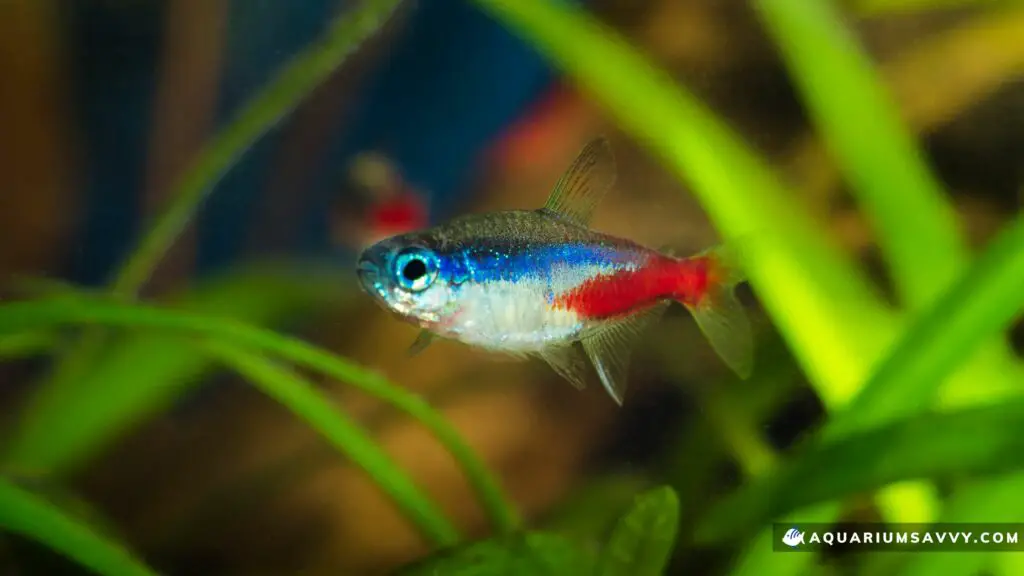The following post provides a comprehensive look into the world of Neon Tetra, covering Neon Tetras natural habitat, care requirements, behavior, breeding, and common diseases, offering valuable insights for both beginner and seasoned aquarists.
Table of Contents
Overview of Neon Tetras
Neon Tetras are one of the most popular and captivating species in the aquarium hobby, known for their vibrant, iridescent coloration and peaceful nature.
As a schooling fish, they create a mesmerizing spectacle, darting in unison through aquatic plants and hiding spots. Despite their small size, they play a significant role in establishing the overall aesthetic of an aquarium.
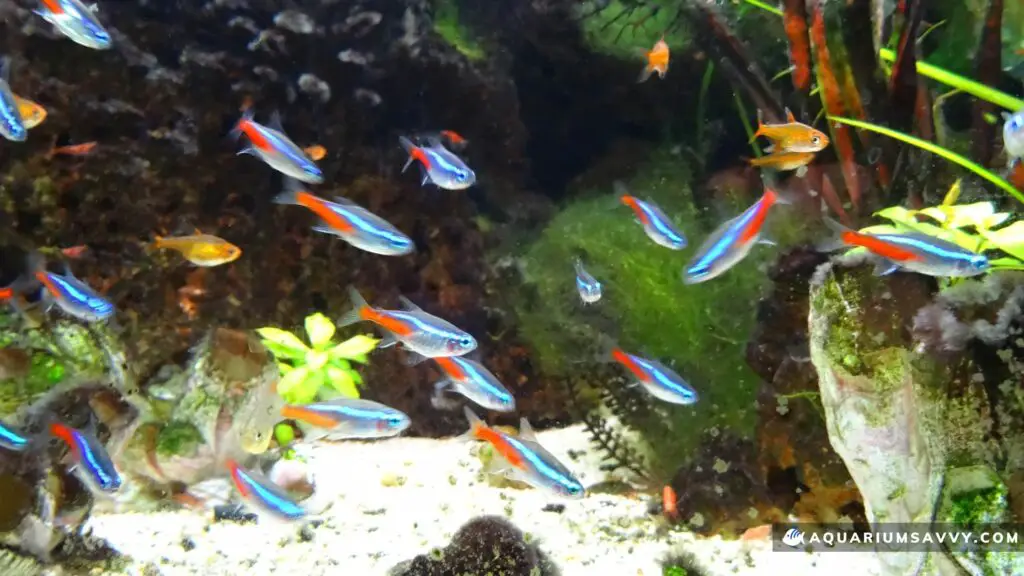
Natural Habitat of Neon Tetras
Understanding the natural habitat of Neon Tetras is crucial to providing them with a comfortable and thriving environment in captivity.
Neon Tetras are native to the freshwater bodies found in the Amazon basin, spanning across countries like Columbia, Peru, and Brazil.
South America’s rich biodiversity and unique ecological conditions have shaped the characteristics of Neon Tetras. Their stunning, bright colors are a reflection of the region’s diverse and vibrant flora and fauna.
They inhabit both blackwater and clearwater streams, often found swimming amidst dense vegetation and over dark substrates.
In the wild, they enjoy slightly acidic to neutral pH levels (around 6.0 to 7.0), soft to moderately hard water, and a temperature range of 72-78°F.
To replicate these conditions, aquarists often use driftwood, which naturally darkens the water due to the tannins it releases, simulating the blackwater habitats.
The tank should be planted with aquatic vegetation and have plenty of hiding places to recreate a low-light environment similar to their natural habitat.
It is essential to cycle a new tank before adding Neon Tetras to ensure a stable water chemistry and establish beneficial bacteria, reducing harmful compounds like ammonia and nitrites.
By embracing the natural habitat of Neon Tetras and understanding their connection to South America this helps to create an environment closely resembling the conditions in the Amazon basin, allowing Neon Tetras to live as they would in the wild.
Physical Characteristics of Neon Tetras
Neon Tetras are easily recognizable for their striking physical characteristics.
They usually grow to about 1.5 inches in length, displaying a torpedo-shaped body with a silver-white belly.
The vibrant iridescent stripes running from their nose to the adipose fin are their most distinguishing feature.
Each side of their body sports a neon-blue stripe above a radiant red stripe, which are created by reflective crystal structures within their skin cells.
These colors can change depending on the light conditions, often appearing more vivid in the dark.
Identifying the differences between male and female Neon Tetras can be a subtle task.
Males typically have a straight blue stripe running along their sides, while females display a slightly bent stripe due to their rounder bellies, which accommodate eggs during breeding.
The unique color-changing ability of Neon Tetras and their bright, iridescent stripes are not only a spectacle to behold but also an adaptation that aids in their survival, offering them both camouflage and a communication tool in their natural habitats.
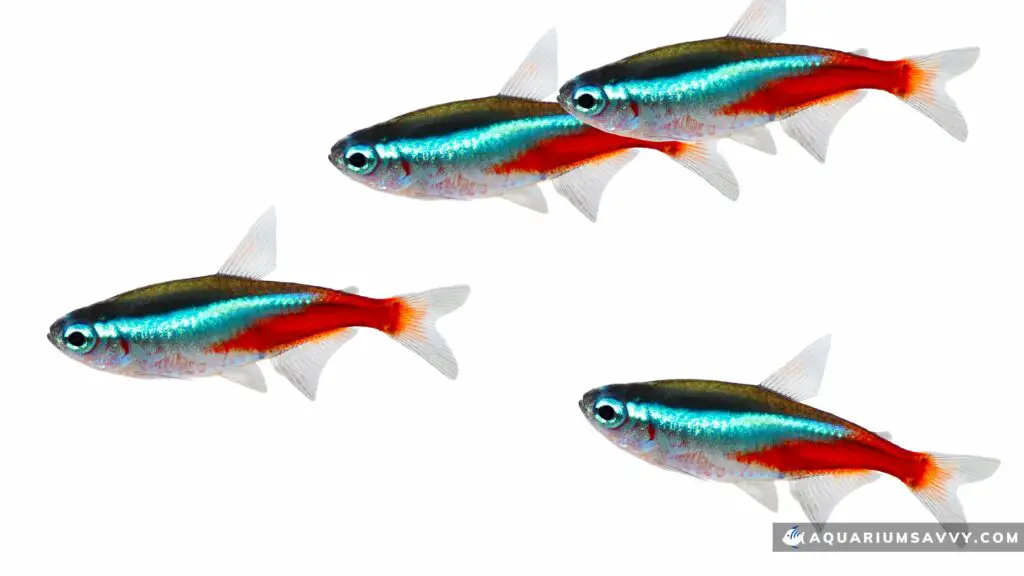
Temperament and Behavior of Neon Tetras
Neon Tetras exhibit a social and peaceful temperament that makes them a favored choice among aquarists.
These popular aquarium fish prefer to live in large communities, often seen swimming in coordinated groups due to their shoaling behavior. This not only offers them protection but also creates a captivating spectacle in the aquarium.
They get along well with non-aggressive species, making them suitable for community tanks.
Their preferred water parameters include a temperature range of 72-78°F, a pH between 6.0 to 7.0, and soft to moderately hard water.
Among these, temperature plays a pivotal role in their activity levels and overall well-being.
One of the most interesting behaviors of Neon Tetras is their ability to alter the color of their stripes. This color-changing phenomenon, which is more pronounced under varying light conditions, serves both as a form of communication and camouflage, adding to their charm and intrigue.
Feeding Habits of Neon Tetras
Neon Tetras exhibit omnivorous feeding habits, with a diverse diet that includes both plant-based and meaty foods.
They enjoy a range of food types, such as flakes, freeze-dried bloodworms, shrimp pellets, brine shrimp, frozen foods, and algae wafers.
They can also consume veggies and specially designed food for green neon tetra diet. Offering a variety in their diet not only keeps them interested but also helps ensure they receive a balanced diet.
An important guideline in feeding Neon Tetras is the 3-minute rule. This means you should only feed them the amount of food they can consume within 3 minutes to prevent overfeeding, which can lead to obesity and bloating.
During their development stages, young Neon Tetras can be fed more frequently with small, nutrient-rich foods like baby brine shrimp, frozen cyclops, and daphnia.
For adult Neon Tetras, feeding them two to three times a day following the 3-minute rule should suffice. Maintaining a feeding schedule and providing a varied diet will help keep your Neon Tetras healthy and well-fed.
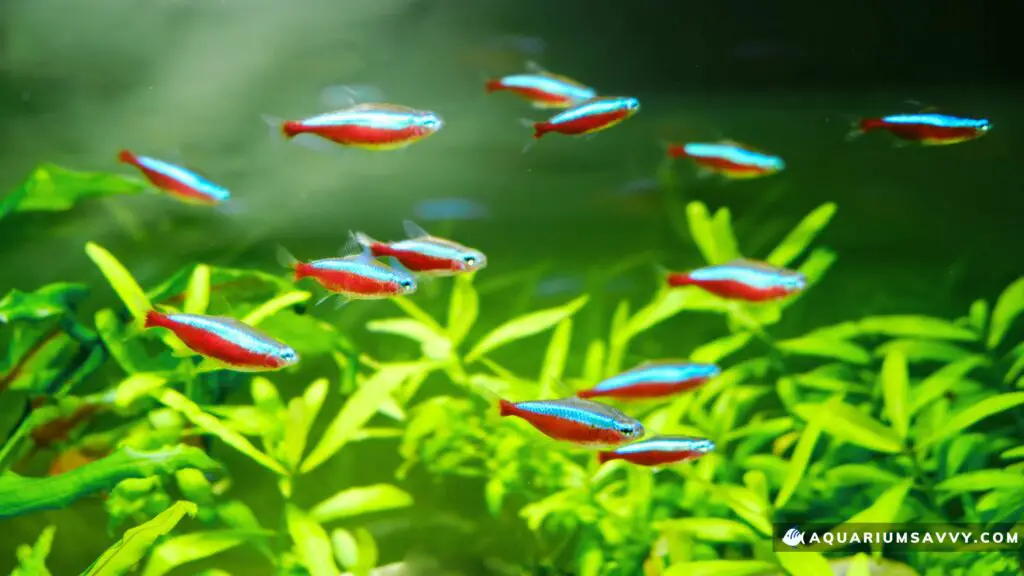
Tank Requirements for Neon Tetras
Creating the right environment for Neon Tetras is crucial for their well-being and longevity. As peaceful, schooling fish, they thrive in a clean freshwater tank with plenty of swimming space and dense vegetation, which mimics their natural habitat.
The tank should ideally be at least 10 gallons for a small school of Neon Tetras, but a 20-gallon tank or larger is even better as it provides more room for them to swim and shoal.
In terms of filtration, a sponge filter or a hang-on back filter can meet their needs, keeping the water clean and free of harmful substances.
However, if Neon Tetras are part of a community tank, the filtration needs of all the inhabitants should be taken into consideration to ensure a healthy environment.
The tank should also maintain stable water parameters, including water temperature, pH, and hardness, to support the well-being of Neon Tetras.
Acidic water plays a significant role in the health and well-being of Neon Tetras. It helps to recreate their natural environment and provides optimal conditions for their growth and vibrant coloration. The pH range of around 6.0 to 7.0 is generally preferred for these captivating fish.
Maintaining acidic water conditions in an aquarium is crucial for the successful care of Neon Tetras. It involves closely monitoring and adjusting the pH levels to match their native habitat. This can be achieved through various means, such as using natural materials like driftwood or adding specific water conditioners designed to lower pH.
One of the reasons why Neon Tetras thrive in acidic water is the impact it has on their overall health. Acidic conditions can help create an environment that inhibits the growth of certain harmful bacteria and parasites, reducing the risk of diseases and infections.
Additionally, acidic water can enhance the coloration of Neon Tetras. The vibrant blue stripe and radiant red stripe on their bodies become more pronounced and vivid in slightly acidic pH levels. This phenomenon adds to the visual appeal of these already stunning fish, captivating aquarium enthusiasts and creating a visually striking display in the tank.
It’s important to note that while Neon Tetras prefer acidic water, the stability of water parameters is paramount. Sudden fluctuations in pH levels can cause stress and harm to the fish. Regular monitoring and maintaining consistent water conditions are essential to ensure their well-being.
Tank Mates for Neon Tetras
Selecting appropriate tank mates for Neon Tetras is crucial as these peaceful fish thrive best in a non-aggressive environment.
Ideal companions should not be large enough to view the smaller Neon Tetras as prey.
Some of the top choices for tank mates include Rasboras, Barbs, and Dwarf Gouramis.
These species share similar water requirements and have a peaceful temperament, making them suitable companions for Neon Tetras.
Bottom-dwelling fish like small catfish also make good tank mates. They tend to keep to themselves, mostly staying at the bottom of the tank, which provides a balanced distribution of fish in the tank.
It’s important to remember that Neon Tetras are schooling fish. To mimic their natural schooling behavior and ensure their well-being, it’s highly recommended to keep at least 15 Neon Tetras together.
This creates a vibrant spectacle in the tank and also provides the Neon Tetras with a sense of safety and community.
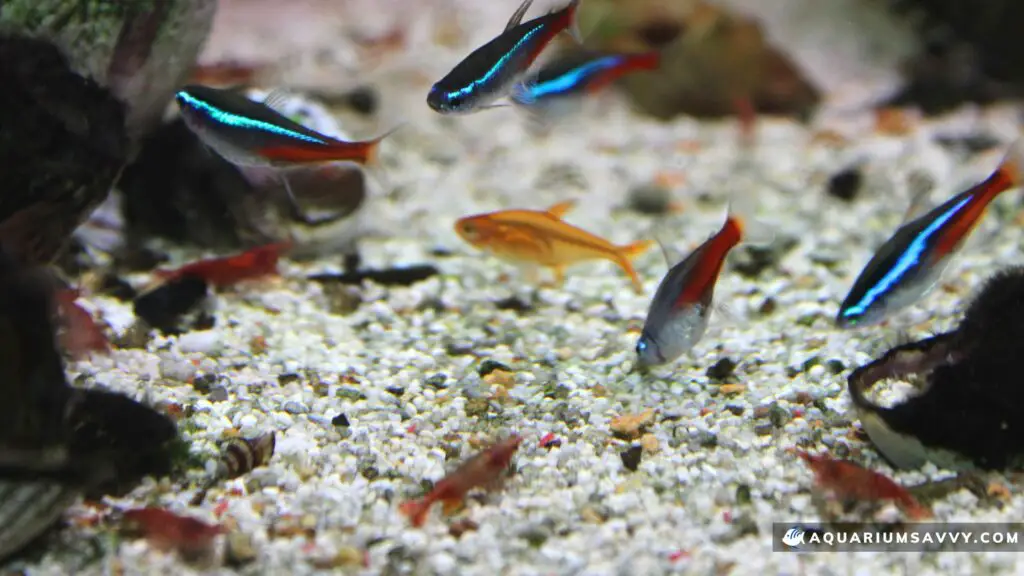
Breeding and Reproduction of Neon Tetras
Breeding Neon Tetras is an exciting yet delicate process that requires specific conditions and careful planning.
The first step involves setting up a separate breeding tank with specific water conditions.
The water should be soft with a slightly acidic to neutral pH level (around 6.0 to 7.0), mimicking their natural breeding habitats in the wild.
Live plants and a sponge filter for gentle filtration are also important to create a safe and comfortable environment for breeding.
Conditioning the breeding pair is a crucial step, typically involving a diet of high-quality foods to stimulate spawning.
Once ready, the pair can be introduced to the breeding tank. It’s important to note that low lighting conditions are preferred as Neon Tetras usually spawn at dawn in dimly lit environments.
The female Neon Tetra can scatter a large number of eggs, typically around 60 to 130, which attach to the plant leaves and substrate. After spawning, it’s recommended to remove the parents from the tank to prevent them from eating the eggs.
The eggs typically hatch within 24 hours, and the fry will start swimming freely in about 3 to 4 days.
They should be fed small, nutrient-rich foods, like freshly hatched brine shrimp, to support their growth.
A tank size of at least 10 gallons is recommended for raising the fry, providing them with ample space to grow and develop.
With careful attention to these details, one can successfully breed and raise a new generation of these colorful fish.
Health Concerns for Neon Tetras
Like all aquarium fish, Neon Tetras are susceptible to a variety of health concerns. Understanding these potential issues can help pet owners take preventative measures and promptly address any problems that may arise.
Some of the most common ailments that can affect Neon Tetras include
- ich, a parasite that causes white spots on the fish’s body;
- fin rot, which leads to the deterioration of the fish’s fins;
- velvet disease, a parasitic infection that presents as a velvety, rust-like coating on the fish’s body.
Maintaining good water quality is crucial in preventing these diseases, as poor water conditions can stress the fish and lead to weakened immune systems.
Regular testing of the water’s pH, hardness, and ammonia, nitrite, and nitrate levels can help ensure a healthy environment for your Neon Tetras.
Additionally, monitoring the behavior of your fish is equally important.
Signs of stress or aggression can be indicators of underlying health problems.
Changes in eating habits, lethargy, and unusual swimming patterns are all signs that a fish may not be feeling well.
By keeping a close eye on your Neon Tetras and maintaining a high-quality environment for them, you can help ensure their longevity and well-being.
What to Expect When Keeping Neon Tetra in an Aquarium
Keeping Neon Tetras in an aquarium can be a rewarding experience due to their bright colors, peaceful temperament, and engaging shoaling behavior.
As schooling fish, Neon Tetras are most comfortable in groups of at least 15, providing a captivating display of coordinated movement and vivid coloration.
Their bright hues can be influenced by water conditions and diet; therefore, it’s essential to maintain ideal water parameters and provide a healthy, varied diet that includes flake food and frozen treats like brine shrimp or bloodworms. This can enhance their coloration and overall health.
Selecting suitable tank mates is another consideration when setting up an aquarium for Neon Tetras.
Non-aggressive fish of similar size, such as Rasboras, Dwarf Gouramis, and small catfish, can create a harmonious, multi-species environment.
These fish can contribute to the overall aesthetic and activity of the tank, offering an engaging spectacle for observers.
Lastly, ensuring your tank mimics the natural habitat of Neon Tetras is key to their wellbeing.
This includes dense vegetation and hiding places such as driftwood or caves, which provide areas for rest and retreat, helping your Neon Tetras to feel secure and comfortable in their home.
Keeping Neon Tetras can be a delightful and satisfying endeavor, provided their needs are met and their environment is well-maintained.
How to Choose the Right Size Tank for a School of Neon Tetra?
Choosing the right size tank for a school of Neon Tetras involves considering their active nature, the need for stable water conditions, and the filtration requirements of the entire aquarium.
A 20-gallon tank is usually ideal for these fish, as it provides ample swimming space and allows for more stable water parameters.
However, a smaller tank of at least 10 gallons can also work, but it requires careful management to prevent drastic water changes, which can stress or even be fatal to these delicate fish.
The choice of filter is also essential in maintaining a healthy environment for Neon Tetras. Because these fish have a relatively small bioload, a sponge filter or a hang-on back filter is typically sufficient.
These types of filters are gentle and won’t create strong currents that can disturb these small fish. They also provide beneficial biological filtration, which is crucial in maintaining healthy water conditions.
Overall, ensuring that you have the right size tank and an appropriate filter for your school of Neon Tetras is key to their health and happiness. A minimum tank size of 10 gallons is recommended.
Tips to Keep Your School of Neon Tetra Healthy and Happy
Keeping a school of Neon Tetras healthy and happy requires a mix of proper environment management and good nutrition.
It’s essential to maintain the water quality in the tank, ensuring the temperature stays within the preferred range of 72-78°F and the pH level remains between 5.5 and 7.5.
Regular water changes and tests can help maintain these conditions.
A balanced diet is another key factor in the health of your Neon Tetras. They should be fed a variety of foods, including flakes, pellets, freeze-dried worms, and brine shrimp. Feeding should occur twice a day, but be careful not to overfeed them, as this can lead to health issues like obesity and water pollution.
Space is also important for these active swimmers. Ensure your tank provides enough room for the school to swim freely, and include hiding spots like plants or caves for them to retreat to.
Since Neon Tetras are schooling fish, it’s best to keep at least five of them together for their comfort and well-being.
Lastly, regular observation of their behavior can help you catch any signs of illness or stress early on. Changes in eating habits, color, or activity level could indicate a potential issue that needs to be addressed.
By following these tips, you can help ensure your school of Neon Tetras thrives in their aquatic home.
Common Diseases that Affect Neons
Neon tetras can be prone to a variety of diseases. The most common and significant among these are Neon Tetra Disease and Hexamita. Prompt recognition of symptoms and treatment is crucial to prevent the spread of disease and maintain a healthy aquarium environment.
Neon Tetra Disease
Neon Tetra Disease is a particularly notorious ailment that specifically targets these species. It is caused by a sporozoan parasite, Pleistophora hyphessobryconis, that initially infects the fish’s intestines and then spreads throughout the body.
Symptoms are often subtle at first, including restlessness, a loss of color, difficulty swimming, and the development of a lumpy appearance due to cysts.
As the disease progresses, the affected fish may exhibit lumps or cysts, a curved spine, and a ‘rotting’ effect, where parts of the fish’s body seem to decay.
It’s crucial to isolate affected fish as soon as possible because the disease can spread quickly in a community tank
Importantly, there are no known cures for this disease, and prevention through good aquarium hygiene and nutrition is essential.
Hexamita
Hexamita is another common disease among neon tetras. It’s caused by a flagellate protozoan and primarily affects the fish’s digestive system.
The most noticeable symptom is a condition known as ‘hole-in-the-head’ disease, where the fish develops small, pit-like holes on its head and along the lateral line.
Affected fish may also show loss of appetite, weight loss, white, slimy feces, and general lethargy.
Prompt treatment with metronidazole-based medications is usually effective at treating Hexamita.
Other Potential Diseases
Neon tetras can also be susceptible to a variety of other diseases. These include:
Ich or White Spot Disease
Manifests as tiny white spots on the fish’s body and fins, and is often accompanied by flashing (rubbing body against surfaces), gasping for air at the water surface, and clamped fins. It can be treated with elevated temperature and aquarium salt or commercial medications.
Fin Rot
Characterized by frayed or disintegrating fins, often with a white or red edge. It’s a bacterial infection that usually occurs in poor water conditions or when the fish is stressed. Antibacterial treatments can be effective against fin rot.
Fungal Infections
These manifest as fluffy white growths on the body or fins of the fish. Fungal infections can be treated with antifungal medications and by improving water quality.
Velvet
A parasitic infection that causes a rusty or gold dust appearance on the fish’s body. Affected fish may also show signs of scratching, rapid gill movement, and loss of appetite. Treatment typically involves using a copper-based medication and reducing light in the aquarium.
Regardless of the disease, prompt treatment is necessary to prevent its spread within the aquarium.
This typically involves diagnosing the disease based on its symptoms, isolating the affected fish if possible, and administering the appropriate medication or treatment.
Always consult with a vet or an aquatic pet specialist if you’re unsure of the diagnosis or treatment.
Advantages and Disadvantages of Keeping Neon Tetra as Pets
Keeping neon tetras as pets can be both a rewarding and challenging experience.
Understanding the advantages and disadvantages of owning these tropical fish is critical to making an informed decision and ensuring they are the right fit for your aquarium.
Advantages of Keeping Neon Tetras
Neon tetras, with their vibrant colors and peaceful nature, are a popular choice among aquarium enthusiasts. Let’s take a look at some of the advantages of owning Neon Tetras.
Peaceful Nature
Neon tetras are well-known for their peaceful nature. They are schooling fish and generally get along well with other small, peaceful fish species, making them an excellent choice for a community aquarium.
Hardiness
Although delicate in appearance, neon tetras are relatively hardy and can adapt to a variety of water conditions, making them suitable for beginners.
Beautiful Colors
One of the primary reasons neon tetras are so popular is their stunning colors. With their metallic blue stripe contrasted with a red tail, they add a vibrant splash of color to any aquarium.
Beginner-Friendly
Neon tetras are ideal for beginner aquarium enthusiasts. They do not require complicated care or an extravagant habitat. A standard tank with good filtration, regular feeding, and stable water conditions is sufficient for these fish.
Disadvantages of Keeping Neon Tetras
However, keeping neon tetras as pets also comes with its share of challenges. Let’s look at some of the disadvantages of owning Neon Tetras.
Minimum School Size
Neon tetras are schooling fish, which means they feel safest and most comfortable when kept in groups of at least six. This requirement can be a challenge for small aquariums or for owners who prefer solitary fish.
Delicate Nature
Despite their hardiness, neon tetras are delicate and can be susceptible to various diseases, such as Neon Tetra Disease and Hexamita. Prompt detection and treatment of these conditions are essential for their wellbeing.
Sensitivity to Water Conditions
Neon tetras are sensitive to changes in water conditions. They require stable water parameters and can become stressed by sudden changes in temperature, pH, or water hardness. This sensitivity requires diligent monitoring and maintenance of the aquarium environment.
In conclusion, the decision to keep neon tetras should take into account both the pros and cons.
Their peaceful nature, hardiness, and vibrant colors make them a delightful addition to any aquarium.
However, their need for a school, delicate nature, and sensitivity to water conditions must also be considered. If you are ready to meet their needs and provide a stable, healthy environment, neon tetras can be a rewarding choice for your aquarium.
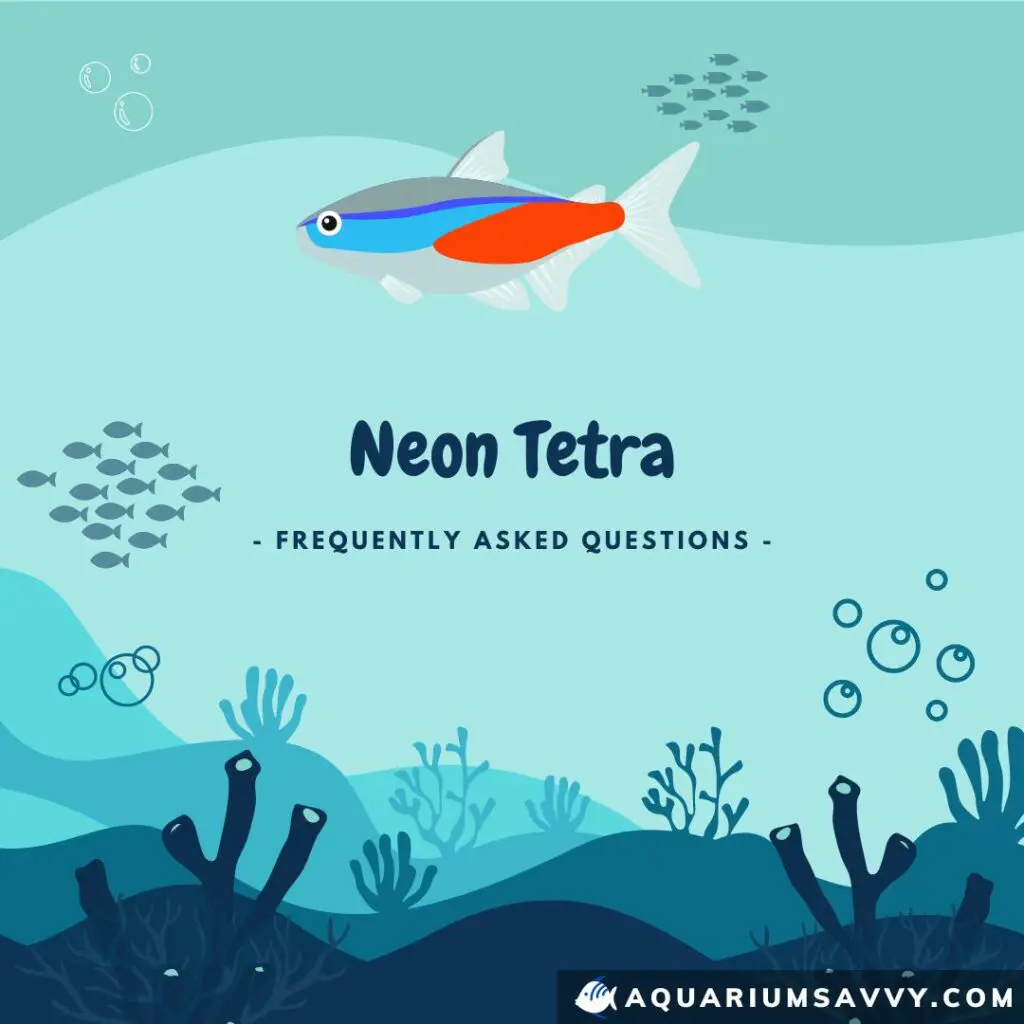
Frequently Asked Questions About Neon Tetra
We have compiled an extensive list of frequently asked questions about Neon Tetra.
Click below to read an in depth answer to the question.

